Folks who dislike Brown Cowbirds for their habit of nest parasitism will likely appreciate this unique ‘revenge’ of the American Goldfinch. We’ll get into that soon but first some goldfinch photos I took yesterday morning.
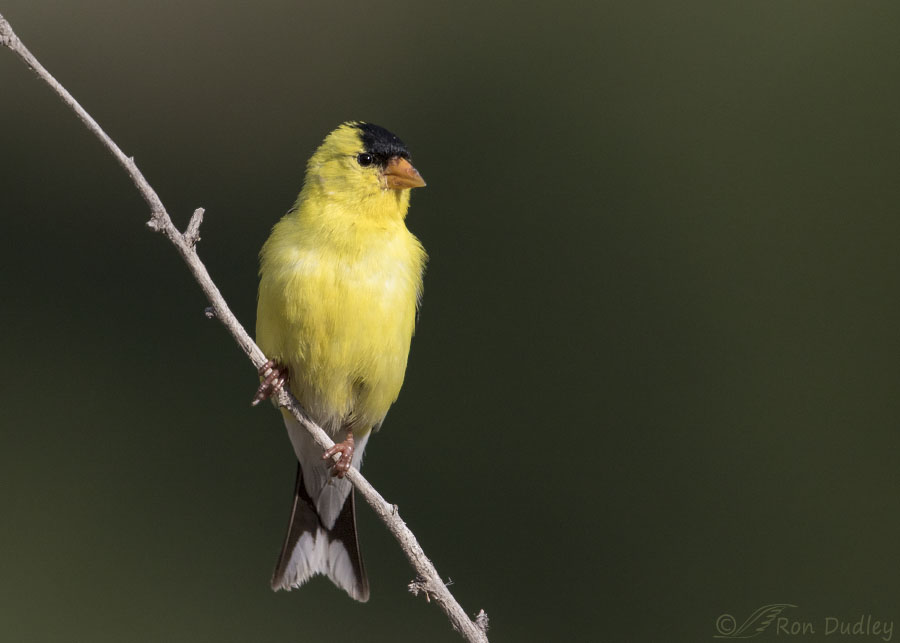
1/5000, f/6.3, ISO 800, Canon 7D Mark II, Canon EF 500mm f/4L IS II USM + EF 1.4 III Extender, not baited, set up or called in
I rarely post images of goldfinches, partly because I don’t photograph them at my feeders but also because I’ve seldom been able to get very close to them in wild situations recently. But yesterday in the Wasatch Mountains this handsome male allowed a close approach. He was on such a steeply angled perch his body was sometimes a little tilted so I decided not to rotate the image to make him vertical because this is the way he really was.
I had pretty good light on the bird but there was partially shaded vegetation in the background on the other side of the canyon so it’s quite dark back there.
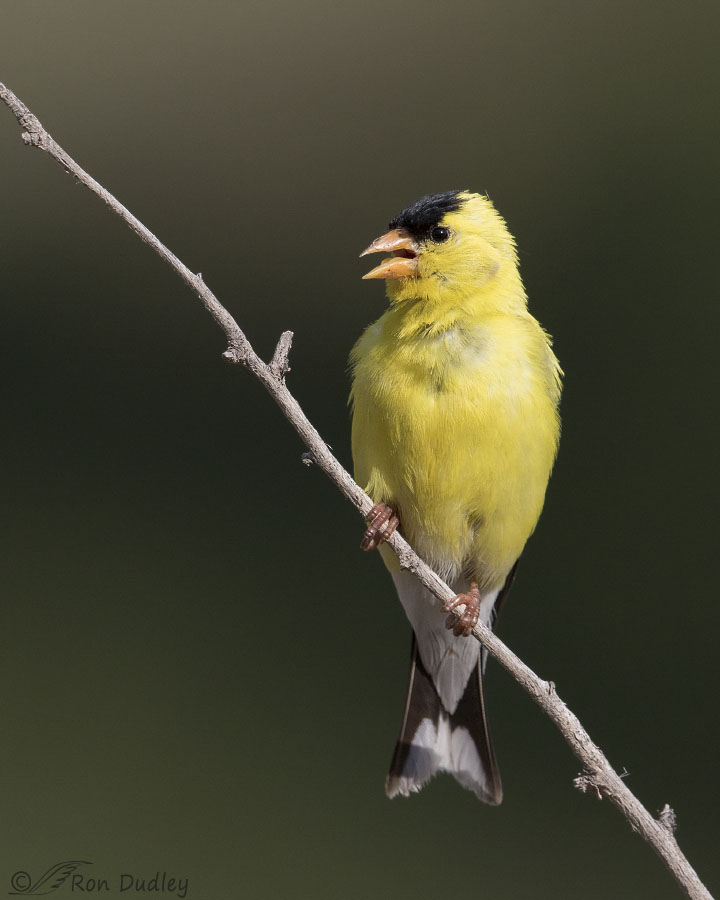
1/4000, f/6.3, ISO 800, Canon 7D Mark II, Canon EF 500mm f/4L IS II USM + EF 1.4 III Extender, not baited, set up or called in
It’s fairly late in the breeding season, even for late-breeding goldfinches, so he wasn’t singing a lot but I did get a few singing poses.
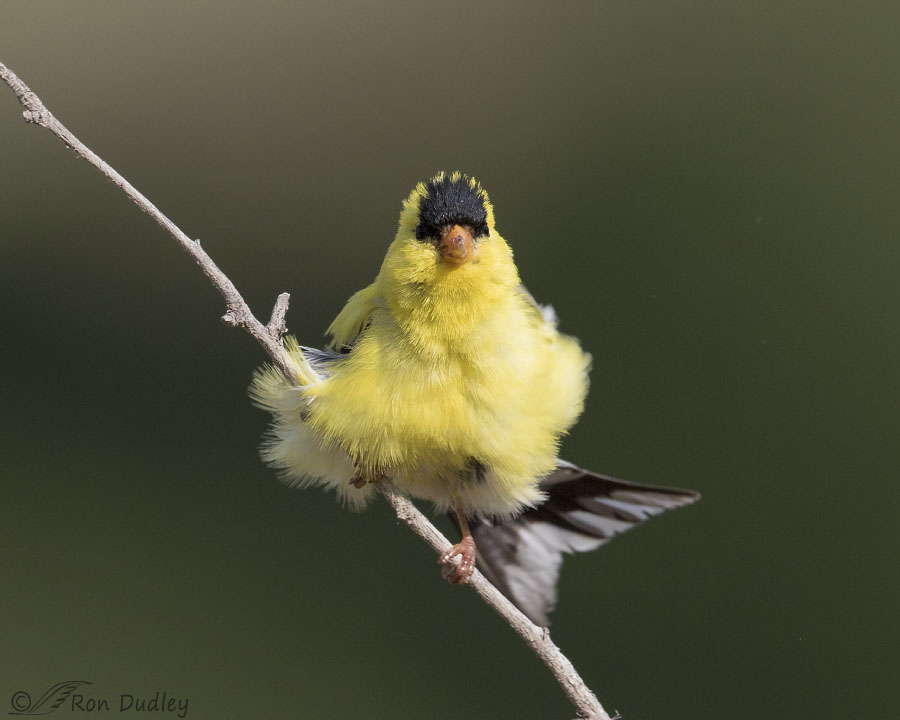
1/3200, f/6.3, ISO 800, Canon 7D Mark II, Canon EF 500mm f/4L IS II USM + EF 1.4 III Extender, not baited, set up or called in
When these guys rouse they put their heart and soul into it, at least this one did. I didn’t get a catch light in this head-on shot but I couldn’t resist posting it anyway because his shaking transformed him into such a fluffball and I like the way it flung his tail to one side.
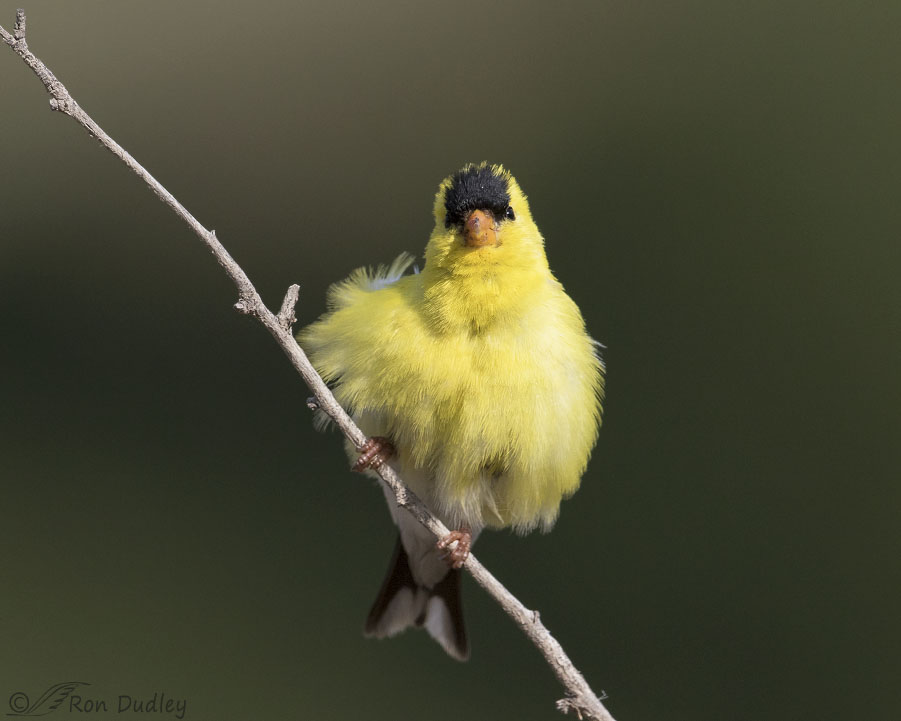
1/4000, f/6.3, ISO 800, Canon 7D Mark II, Canon EF 500mm f/4L IS II USM + EF 1.4 III Extender, not baited, set up or called in
Here he’s beginning to recover from the rouse and I even got a catch light in a front view.
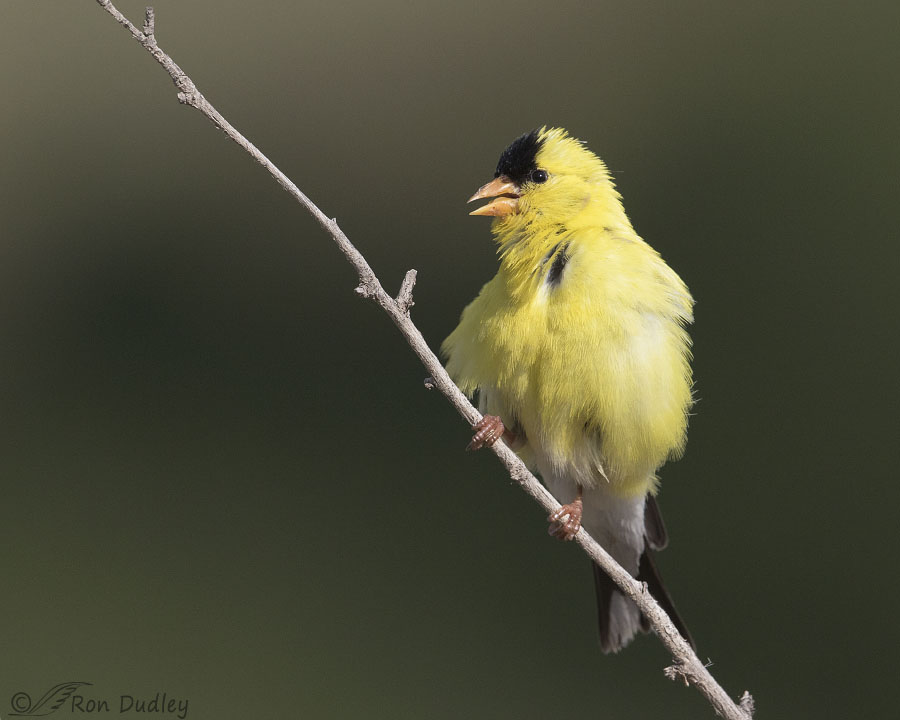
1/5000, f/6.3, ISO 800, Canon 7D Mark II, Canon EF 500mm f/4L IS II USM + EF 1.4 III Extender, not baited, set up or called in
And he hadn’t even sleeked down again before he resumed his singing.
Ok, what about this revenge thing?
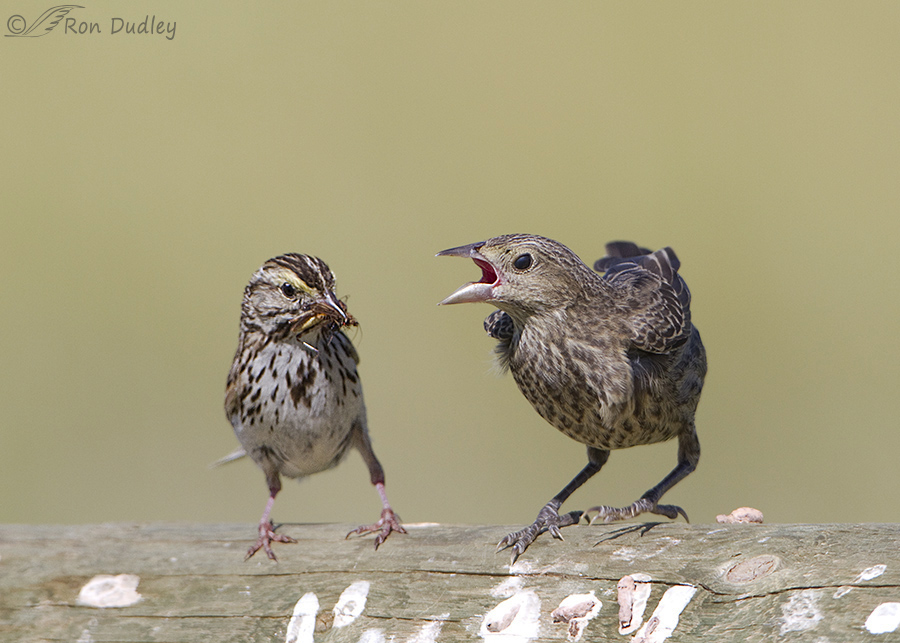
1/1600, f/6.3, ISO 400, Canon 7D, Canon EF 500mm f/4L IS II USM, not baited, set up or called in
As many of my readers know Brown Cowbirds are nest parasites. Adult females lay their eggs in the nests of other songbirds (they never build their own nests) and the rightful owners of the nest unwittingly raise the youngsters as their own. Cowbirds are larger than many of their songbird hosts and their eggs hatch quickly and their offspring grow very fast so the chicks of the nest owners get little food and often don’t make it for various unpleasant reasons – but the cowbird chicks thrive.
In this photo we see an adult Savannah Sparrow in Montana’s Centennial Valley about to feed a beak-full of insects to a newly fledged cowbird chick it has unwittingly raised. Yes, the size difference is dramatic and pretty silly looking.
Ok, here’s where the “revenge” factor enters the picture with goldfinches. Virtually all songbirds, even the strict seed-eaters, switch to a partly or completely insectivorous diet during the breeding season because growing chicks need a lot of protein. But goldfinches are almost strictly seed-eaters even during the breeding season, suggesting that they have adapted to obtaining sufficient protein from a seed diet. And that’s what they feed to their chicks, including parasitic cowbird chicks in their nests.
So, even though the cowbird chicks in goldfinch nests hatch successfully their growth is retarded for lack of the protein they require and almost all of them die before they can leave the nest.
It’s almost like the goldfinches are saying “If you have the unmitigated gall to lay your eggs in my nest and make me feed your youngsters at the expense of my own I’ll make sure your kids don’t survive”. That’s close enough to revenge for me, though of course it isn’t, not really.
Personally I don’t have a problem with the nest parasitism of cowbirds but I’m also comfortable with its lethal results for their chicks when they parasitize goldfinch nests because it’s all natural. But it does make me wonder if, through behavioral adaptation, cowbirds will eventually learn to avoid parasitizing goldfinch nests and take their “business” elsewhere.
The ways of evolution are truly amazing.
Ron


Beautiful goldfinch images and very interesting information about the poor starving baby cowbirds. I think you may be right about how cowbirds may evolve. Look how quickly they adapted to the loss of bison herds.
What a delightful post! A great way to end my day (we were on planes and driving all day today). The information about Goldfinches and their lack of accommodating the dietary needs of a Cowbird chick make me respect them (as well as Catbirds) even more. The rousing shots make this Goldfinch look like Big Bird…
Your kind words about my post are very much appreciated, Susan. I’ve been having a challenging evening and your comment made it a little easier to bear.
LOVE that third photo. I have a busy and likely fraught day ahead and will hold that image in my heart.
Smiling at the goldfinch revenge. ‘My house, my rules.’
I hope that image helps to get you through your difficult day, EC.
“MOTHER NATURE ” is a real bitch!!!
She can be.
Fascinating to know about the Goldfinch/Cowbird evolution. The Goldfinches are eating an enormous amount of seed from my feeders, or more accurately, eating some and flicking more on the ground for the doves, grosbeaks, squirrels, etc. to devour. Your photos give me a renewed appreciation for so common a bird.
Goldfinches can sure seem like gluttons at times. Thanks, Lyle.
Beautiful photos, I took some of a gold finch the other day while in the Wasatch, mine did not turn out sharp. I was sad about it because the colors were so nice and he was so co-operative. I am hoping I did not damage my camera in Australia. The camera and I took 2 hard falls. One broke the UV filter and jammed it onto the lens. My balance is off since my TIA and Australia is a country of one inch rises at all pavement changes, they don’t mention that in “All the things trying to kill you in Australia”.
Geez, that pavement rise is bizarre. And dangerous. I hope your gear turns out to be ok, April.
I am so sorry that my country tried to kill you in a sneaky and understated way. And hope there were some up sides to the trip anyway.
The goldfinch shots delight me! They are just rousingly excellent.
And I rousingly appreciate what you said about them, Martha!
Great shots, nice to be able to take pictures of them out and about rather than on a feeder.
Love Evolution! But, I suppose that is probably because I am a biologist/naturalist by training and past work. Evolution, genetics and ecology were some of my favorites to teach.
We have a lot of Goldfinches at our feeders, mostly males now, females, it seems, come later after their nestlings fledge.
I agree with you about those 3 favorites to teach, Dick. Thanks.
Great lesson about the “dark side” of bird species interaction. John
Thanks, John.
The evolution of behavioral traits is fascinating and I think too often overlooked in favor of physical traits in the whole discussion of natural selection. NS will be part of my curriculum for next year, so I’m sure I’ll be contacting you about some shots — like the last one.
Speaking of behaviors, the rousing shots are hilarious! Goldfinches certainly have some very effective behaviors!
I strongly agree with you about behavior vs physical traits, Marty. Thank you.
Today’s Bliss comic was highly topical. https://www.gocomics.com/bliss/2018/07/18
The puffball pose was fun. And that was very interesting about the revenge.
Thank you, Arwen.
Thanks for the beautiful American Goldfinch photos and the education. Had no idea Cowbirds did that. Both Brown-headed and Bronzed are common here, but never heard that interesting information about them. Lesser Goldfinches are very common here, but not American Goldfinches. Good post Ron, hope the finger is getting better every day.
Everett Sanborn, Prescott AZ
I’d like to see a Bronzed Cowbird some day. Thanks, Everett.
I loved your rousing shots–makes a tiny bird truly look like “Big Bird”……..
Thank you, Kris.
That would be a fascinating adaptive change in Cowbird behavior if they would make such a adaptation. You would have thought though that if there were sufficient pressure the change would have already occurred. Apparently Cowbirds are do sufficiently well even with the mortality rate of chicks laid in Goldfinch nests. Perhaps it’s in the works and we just can’t see it because we are here for such a minisquel amount of time. Love your Gold Finch!
Who knows, Frank. It could go either way.
I also wondered if goldfinches went to a strictly seed eating diet during the breeding season as an evolutionary strategy to deal with cowbirds…?
Very interesting post. Thank you for taking the effort to write it.
The goldfinch is beautiful. We also have goldfinches here but european goldfinch is very different in colors from yours. We name it “Pintassilgo”.
Wish you a fast recovery on the finger front.
I’ve seen photos of your European Goldfinch and I think its colors are beautiful. Thanks, Jorge.
Interesting that the Goldfinch have found a way to deal with the cowbird thing. Thought the Pee Wee nest I was watching had one but don’t think so now – mixed feelings about it all even if it is “nature” who is a bitch at times Beautiful shots of the male goldfinch.
Beautiful shots of the male goldfinch.  We have lots of them in the yard for sure! I have noticed that they hit the feeder heavily when they first come, slow way down for awhile as natural foods come in and then pick up again towards fall while stocking up and teaching the young about the feeders.
We have lots of them in the yard for sure! I have noticed that they hit the feeder heavily when they first come, slow way down for awhile as natural foods come in and then pick up again towards fall while stocking up and teaching the young about the feeders.
Judy, I noticed some of the same things you mention about goldfinches at my feeders when they used to come to it. They seldom do anymore for some reason although Lesser Goldfinches do show up in good numbers at certain times of the year.
Love the goldfinch pictures .. I don’t dislike cowbirds . They seem to be the lesser evil .. when you think about all the other birds that actually rob nests by eating eggs or baby birds .. we all love the bald eagle but he’s a bloody bully ..as is the Raven .. swallowing chicks whole .. horned owls robbing nests .. well documented .. how about those cute cute baby penguins being eaten by big ugly birds….it’s tough being a bird .
Yes, it is tough. You make some good points, Marina.